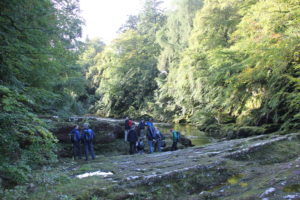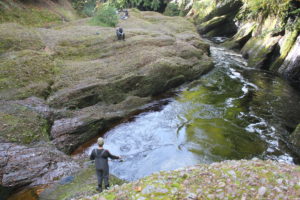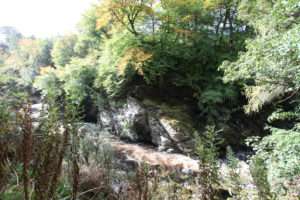Review: ‘The Old Red Sandstone and Highland Border Complex at Glen Esk’
By David Jones, Shell U.K Limited
The PESGB field trip to examine exposures of the Old Red Sandstone and Highland Border Complex in Glen Esk, Aberdeenshire was run for the second time in a year on Saturday 30th September following the success of the previous trip held back in April 2017.
This half-day field trip, led by Simon Gould of Mearns Geoscience Ltd, assisted by Henk Kombrink and Mike Scotting, was attended by a total of 17 other PESGB members with a variety of experience levels and from different Geoscience backgrounds. The field trip followed the ‘Blue Door’ walk along the bank of the River North Esk, north of Gannochy Bridge, approximately 2km from Edzell and took place on a crisp and sunny Scottish Autumn morning in an area known for its outstanding natural beauty as well as it’s geological features.
Geological highlights included fantastic exposures of steeply dipping Lower Old Red Sandstone (Early Devonian) sedimentary rocks within the NW limb of the Strathmore syncline including the Teith Sandstone and Gannochy Conglomerate, the former being cut by a Carboniferous basaltic dyke some 10m wide. The group discussed the evidence for local sediment source areas along the fringes of the Caledonian uplands in the form of alluvial fans in addition to sediment source areas further afield in Scandinavia based on grain size, sorting and the lithology of the clasts. The origin and style of the horizontal fracturing seen within the steeply dipping units, and the significance of fluvial channel sand bodies and bar forms present within the more heterolithic conglomerates, were also topics of discussion.
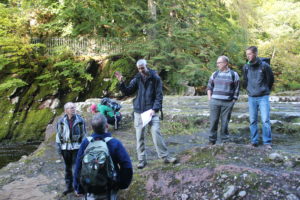
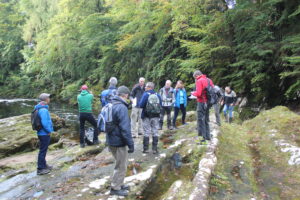
The difficulty in identifying the location of the Highland Boundary fault zone itself posed a real challenge for the group due to the poorly exposed nature of the Early Devonian Cromlix Mudstone, Lintrathen Tuff and Cambro-Ordovician Margie Series of the Highland Border Complex on either side of the fault as well as the presence of significant recent alluvial floodplain deposits limiting exposure to only small sections along the river bank. Another notable geological feature examined during the field trip included the Lintrathen Tuff, considered to represent the product of contemporaneous volcanic activity within the Midland Valley of Scotland with numerous igneous centres and extrusive volcanic sequences present there and further to the west during Early Devonian times.
The field trip was rounded off by examining the complex structural deformation features present within the low-grade metamorphic rocks of the Highland Border Complex, as indicated by several phases of folding and the presence of shear zones in a section of the Greenstone Series exposed north of the Highland Boundary Fault which also included possible pillow lavas.
Following the completion of the field trip the participants were treated to a very enjoyable lunch at ‘The Burn’, a stunning stately home with a fascinating history dating back to the late 18th century now run as a charity and made use of by Universities for residential courses and conferences.
In summary, this was a thoroughly enjoyable and informative geology field trip which offers the opportunity for PESGB members to examine some classic exposures of the Old Red Sandstone and Highland Border Complex within easy reach from Aberdeen and will also be of interest to those working on fluvial reservoirs in both an Exploration or Production setting.
